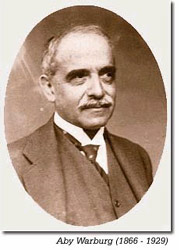WHAT IS ICONOLOGY?
Iconology derives from Greek roots that combine to form a "science of images."
Since the sixteenth century, the term has been used to denote various forms of organized knowledge about images, including collections of portraits and allegories.
 Early in the 20th century, art historian Aby Warburg (1866-1929) used the term as a label for a method of investigating the lost meaning of historical imagery.
In a 1912 lecture concerning the obscure sources of a Renaissance fresco,
Warburg threw open the doors to a new method of visual analysis — grounded in
human emotion, anchored by clear literary references, and enlivened by a keen
sense of the vitality and significance of precedent. The late Kenneth Lord Clarke claimed that this lecture changed the course of his life. Warburg's central insights have been methodically explored and expanded by each generation since and have found an institutional home in a research institute that bears his name at the University of London.
Early in the 20th century, art historian Aby Warburg (1866-1929) used the term as a label for a method of investigating the lost meaning of historical imagery.
In a 1912 lecture concerning the obscure sources of a Renaissance fresco,
Warburg threw open the doors to a new method of visual analysis — grounded in
human emotion, anchored by clear literary references, and enlivened by a keen
sense of the vitality and significance of precedent. The late Kenneth Lord Clarke claimed that this lecture changed the course of his life. Warburg's central insights have been methodically explored and expanded by each generation since and have found an institutional home in a research institute that bears his name at the University of London.
In 1939, Warburg's most famous protege, Erwin Panofsky (1892-1968) penned an influential book that bore the title Studies in Iconology. By virtue of his vast erudition and personal charm, Panofsky's iconological method became the de facto method for sophisticated art historical scholarship from the 1930s to the 1980s in North America.
While Panofsky used iconology to explore the stylistically cohesive aspects of entire epochs as evidence of literary and philosophical tendencies, Warburg was more concerned with a different set of problems.
Specifically, Warburg sought to explore the uncanny coincidences among ritualistic imagery from various cultures, ranging from ancient Greece to Florentine Renaissance to the Hopi tribes in New Mexico.
Warburg discerned peculiar "emotional formulas" (Pathosformeln), patterns of depicting the human body, that could account for certain ahistorical representations of universal human aspirations.
As early as 1884, Warburg had grasped the lesson of Charles Darwin's The Expression of the Emotions in Man and Animals (1872) for the study of art history, correctly seeing the application of facial expression as a significant aspect of our on-going relationship with art and ritual objects.
Applied Iconology is the name I have chosen for the application of the Warburg's general area of inquiry to commercial imagery and persuasion.
At Applied Iconology, we seek to capture the core emotional engagement your customers have with your category, product or brand and blow out the known visual coordinates in a comprehensive optical encyclopedia of their emotional engagement.
With this encyclopedia of emotional expression, we then explore how to expand your current visual and perceptual equities to include specific emotional cues to deepen your message's human impact and commercial value.
